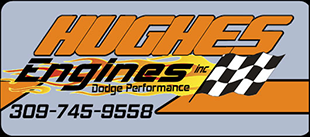|
|
#3---Edelbrock Victor Cylinder Heads
Edelbrocks Newest Offering for Chryslers | 6/25/2014
Dave Hughes |
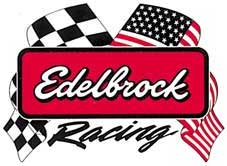
Latest flow is over 360cfm @ .650" lift on stock 440 Ports.
When using the Max Wedge port heads flow is up to 379cfm @ .750" lift.
+++++++++++++++++++++++++++++++++++++++++++++++++++++++++++++++++++++++++++++++
Flow numbers now listed!
As promised, we are releasing photos, tech, and life giving flow numbers from our test on these heads the minute they arrived and The test head is here!!!
Before you (or the chatters) get all wound up about the flow numbers (and they are goooood!) maybe these heads are not for you.
Part EDE 77919
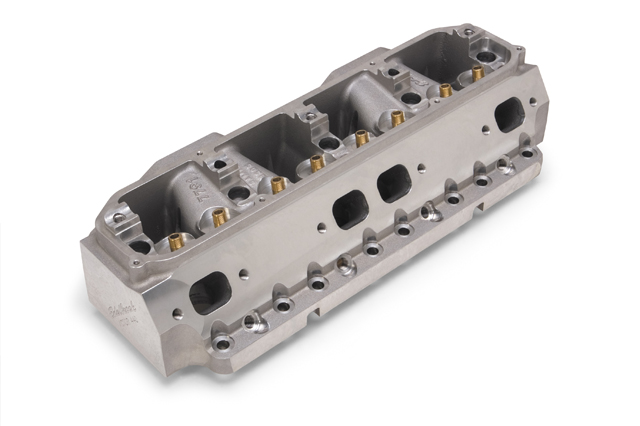
Read this tech article closely before ordering these heads. These are race heads designed for serious race efforts.
They have the same bolt locations for the head bolts, intake, exhaust, valve covers and rockers. Also, the valves are in the same lousy off-center location as the original iron heads, which means the heads will work with standard shelf pistons, stroker or not. This also means that like all stock valve location heads, the flow at higher lifts becomes restricted by the cylinder walls. In other words you can bolt them on a stock LB or RB block.
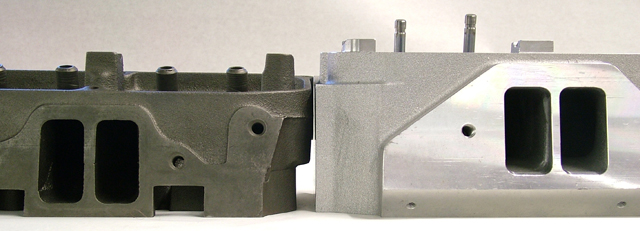
You can even bolt on the stock iron intake and exhaust manifolds.just dont use them.They will bolt on but their locations are dramatically moved.
This view of the intake surface ports compares the stock iron head and the new Victor. The first clue here is the raised location of the intake ports. These are race heads! The bottom of the intake port is about .800 higher off the deck than the original. The port is 1.210 wide and 2.240 tall, perfect for our combo intake gaskets #3266 at the standard 440 port opening size. The carb location will be raised up about .500"
The stock valve covers can be used and its location has been raised up. It is about .625 higher on the exhaust side and about 1.06 taller on the intake side. This will give the pushrod side (intake) more internal clearance and position the valve cover at more of an angle.
The rocker shaft saddles are about .400 higher which will necessitate pushrods at least that much longer. Speaking of pushrods, in previous and most other heads, the pushrod tunnel in the head was the narrow spot in the port (smallest cross-sectional area). This however, is not the case with the Victors. The exhaust ports are raised up .250" but the spacing remains the same.
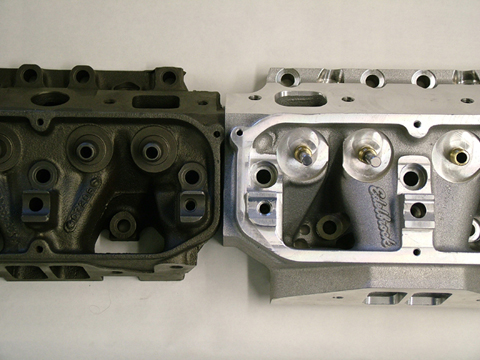
The pushrod positions are moved away from their port wall about .470 each. What this does is Eliminate the pushrod pinch in the Port but requires .600 offset intake rocker arms which we have (HUG 15153 or HUG 15253). The exhaust pushrod location is not changed. At the time of these photos the rockers were a work in progress. they will become available about the same time that the heads get here in 1.5, 1.6:1 and 1.7:1 ratios. We will sell intake rockers only for those of you who have good exhaust rockers to use on the new Victor heads.
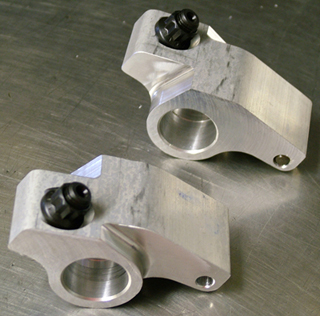 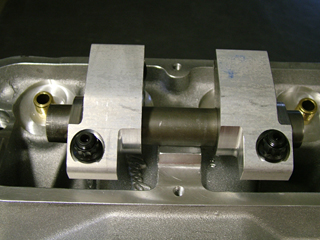
The intake pushrod tunnels are tipped away from each other to accommodate the angles pushrods. These may require some grinding to clear the pushrods with a different rocker brand or ratio. The MOPAR folks may not be as familiar with the Victor line as the Chevy & Ford guys are. What this means is the Victor parts are not always "ready-to-bolt-on" and in many situations may require some custom work before they can be installed.
The curved wall of the port is next to nonexistent now as you can see in this photo below.
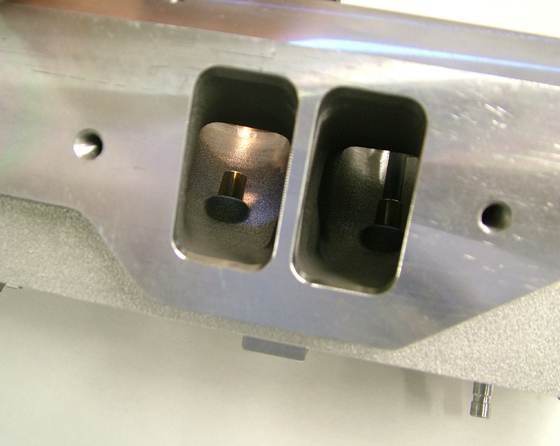
This result is a port that looks nothing like any previous wedge intake intake runner. It is actually closer to, dare I say it?, the 426 Hemi intake ports. All of the old air that has flowed through wedge heads for the last 50 years will now become confused not knowing which wall to adhere to. (That's suppose to be funny!)
More trick stuff. The part of the bronze valve guide you see protruding into the port is only .400" O.D. instead of the more common .500" size. "All the better to flow more air" says the big bad flow bench!
This intake port is big, long & straight and the smallest cross section is a whopping 3.13 square inches at the short turn with 440 ports....WOW!
What does that mean?
1. A Max Wedge port opening might finally prove itself of some worth.
2. A mistake by Edelbrock?
3. Or, do they know something you don't and are trying to show you?
Well, to help answer this question we can look at the Victor's competition. Why yes, they do seem to be in the same catergory as the INDY E-Z, S/R and 440-1. They are probably the same as some of the Brodix heads as well but we can't say for sure because we never see them nor have we tested them, and the Mopar Performance stuff is a little long in the tooth (old).
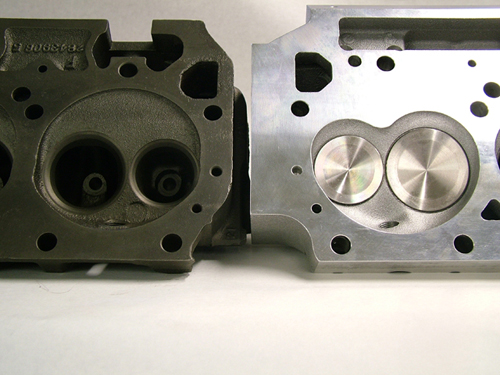
In the above photo the cardioid shaped (that means heart shaped for you chatters) chambers illustrate several things.
1. There is considerable clearance around the valves on the quench side. This may help
promote good flow at lower lifts, reduce the length of the quench area to speed up the
burning, or it may help keep the chambers at 75cc.
2. Notice the angled plug position, which is the same as in the RPM heads. There is not a
lot of room for change here.
3. With the standard valve location the 2.190" and 1.81" valves are about as large as is
physically possible.
The chamber wall proximity becomes a drawback with a larger intake which the port could supply. Especially at the higher lifts this heads is capable of working with.
This next photo shows the drainback holes.
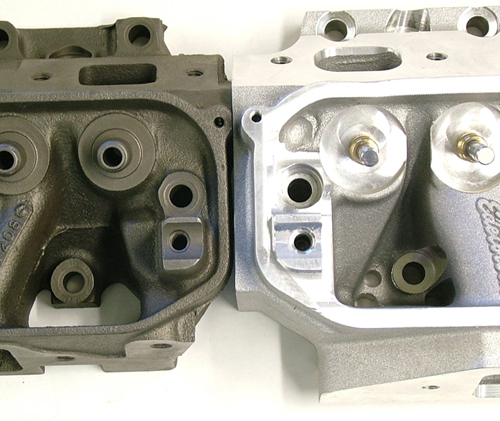
They consist of one 3/8" hole along with 2 pushrod openings. The intake manifold surface of the head is wider to allow all stock width manifolds to bolt on.
The valve spring spot face is 1.725" O.D. and if a cup is used will allow a 1.600" O.D. spring. Did we mention that this is a race head????
Back in the second photo look at how far the intake gasket surface is extended out compared to the stock iron piece. The photo bleow more clearly shows this.
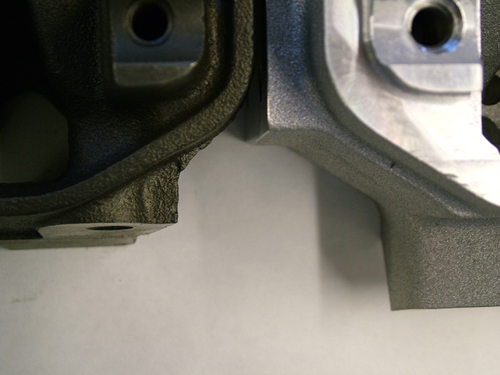
Below is a link that shows flow numbers of these heads in their stock, as boxed configuration as well as with the Hughes C.N.C. porting.
To view the flow chart for this head click the button below.

|
|
| | Home | Phone: 309-745-9558 | Email: information@hughesengines.com |
